
Winter Squash U-Pick Orchards in SW OR: Lane, Coos, Deschutes, Douglas Counties in 2024, by county
Below are the U-Pick orchards and farms for winter squash that we know of in this area. Not all areas of any state, nor even every state, have winter squash orchards that are open to the public. If you know of any others, please tell us using the add a farm form!
Remember to always check with the farm's own website or Facebook page before you go - or call or email them if they don't have a website or Facebook page. Conditions at the farms and crops can change literally overnight, so if you want to avoid a wasted trip out there - check with the farm directly before you go! If I cannot reach them, I DON'T GO!
PLEASE report closed farms, broken links and incorrect info using the "Report Corrections" form below.
Douglas County
- Brosi Sugartree Farms - strawberries, blueberries, broccoli, bush, beans, cabbage, cantaloupe, cauliflower, cherries, corn, cucumbers, nectarines, peaches, pears, peppers, plums, prunes, pumpkins, summer squash, tomatoes, u cut flowers, watermelon, winter squash ,
540 Winston Section Road, Winston, OR, OR 97496. Phone: 541) 679-1472. Open: Call for for hours and availability; typically, around the end of May with Strawberries and Cherries; 7 days a week, 9 am to 6 pm, with u-pick closing at 5:30pm. Click here for a map and directions. Payment: Cash, WIC Vouchers . Brosi Sugartree Farms . NOTE: prices are from 2020; check on their page for this year's prices: Apples- "Mutsu"- U-pick: .60 lb. "Gala"- In stand: .99 lb or $13.95 box. Moyer Plums- U-pick: $1.00 lb. In Stand: $1.89 lb or $18 box.Prunes- Ready around the end of September.*Cauliflower. *Cabbage (red & green). *Bell Peppers. *Chili Peppers. *Walla-Walla Onions. *Sweet Corn. *Pickling Cucumbers (Order list). *Lemon Cucumbers. *Summer Squash (Zucchini, Yellow crookneck, & Patty pan. *Green Beans. *Slicing Cucumbers: 5/$1!! *Broccoli: .49 lb!! *Jumbo Pickling Cucumbers: 4/$1.00 or $11/#20 box.Melons- Our Watermelon & Cantaloupe are exceptional right now!!Tomatoes- Coming on very slowly, but once they start up, we will have more than enough for everyone!! Possibly another few weeks before they are plentiful.Pears- "Bosc"- U-pick: .39 lb. "Comice" & "Bartlett"- In stand: .69 lb or $10.95 box. *Farm Fresh Eggs. *Local Honey. *Jams. *Syrups. *Baked Goods.
Comments from a visitor on July 05, 2011: "love this farm. I think they have a corn maze in fall. and it seems I have heard about hay rides too. " - Norm Lehne Garden & Orchards - apples, beans, beets, carrots, corn (sweet), cucumbers, eggplant, flowers, herbs or spices, nectarines, pears, peaches, peppers, plums, pumpkins, summer squash, winter squash, tomatoes, other vegetables, Other fruit or veg,
386 Cleveland Rapids Road, Roseburg, OR 97470. Phone: 541-672-2745. Open: Summer Hours mid July thru Sept: Monday to Saturday, 8 am to 6pm. Directions: From Roseburg, Interstate 5, Garden Valley Exit, #125. Go west on Garden Valley Road about 5.3 miles from freeway, staying in right hand lane, to the rural fire station. Garden Valley Road makes a left around the fire station. Continue another 2.5 miles to Cleveland Rapids Road. Turn left. Norm Lehne Garden & Orchards is the first house on . Click here for a map and directions. Payment: Cash, Check.
Norm Lehne Garden & Orchards Facebook page. . Summer Hours (mid July thru Sept): Monday to Saturday, 8 am to 6pm. Sunday, 8 am to 4 pm. Fall Hours (October) Monday to Saturday, 9 am to 5 pm. Closed Sundays. the left on Cleveland Rapids Road. Look for signs. Crops are usually available in July, August, September, October. Norm picks our cantaloupes and watermelons. We also grow black-eye peas, cabbage, cauliflower and broccoli. Dried Hazelnuts are available in October. Call for details on these crops.
Lane County
- McKenzie River Farm (aka, OrganicRedneck) - blueberries, strawberries, pumpkins, green beans, winter squash
44382 McKenzie hwy, Leaburg, OR 97489. Phone: (541) 896-3928. Email: jack@mckenzieriverfarm.com. Open: blueberries Ripening until mid July. Click here for a map and directions. Payment: cash or check, can do credit most times. . We also u-pick green beans, and have an heirloom pumpkins and winter squash u-pick patch in the fall with over 25 varieties of squash and pumpkins. And u-pick strawberries. Bring your own containers: a box, bag, basket, colander, an old berry flat from elsewhere, whatever works. We have buckets to pick into but you should bring something to take them home in. U-Pick strawberries should be available by July 12th, demand is likely to outstrip supply so we will be open for u-pick until the field is picked out, then we will be closed until enough ripen again. There may not be a ton but what's out there are gorgeous. We will also have some picked ones on hand from our other patch down the street, so if you don't get to pick any you can still get your fix. This is where it's at: Big juicy blueberries, all the tasting you can handle. We have a 2.5 acre field that is solely dedicated to U-Pick (that means more berries for you). Blueberries are one of the nicest berries to pick and especially with our tall bushes that provide shade and easy reach, safely convenient and comfortable for all ages. When you pick them yourself you get the best and can eat along the way. Available July-Aug. - Tinker Road Orchard - Uses natural growing practices, apples, blackberries, blueberries, figs, herbs or spices, pears, pumpkins, winter squash,
36429 Tinker Road, Pleasant Hill, OR 97455. Phone: 541 744-6960. Email: nestfarm@msn.com. Open: by appointment. Click here for a map and directions. Payment: Cash, Check. . Crops are usually available in June, July, August, September, October, November. We use natural practices, but are not yet certified Organic. Please don't come unless you've spoken to us. We live across Enterprise, not in one of the three little houses on the farm (no need to bother the tenants!) Sometimes things get a bit overgrown, just nature at work. We now have lambs and beautiful handspinning/felting wool for sale.
Choosing a winter squash
Winter squash comes in many sizes, shapes and colors. Choosing a winter squash that meets your needs and the taste you will like can be tough without a guide! This page provides you that information, plus nutritional analysis and links to our freezing and canning pages!
Unlike its summer squash, which is best when harvested very young and used right away, winter squash is harvested at a mature age, which makes the outer skin hard and inedible. The skin, however, is protective and increases its storage life. Winter squash can be stored for 3 months or longer if kept in a cool dark place, like a basement or garage. I've had winter squash last a full year when stored like this!
The yellow and orange flesh of the winter squash is more nutritious and richer in vitamins, especially beta carotene, than summer squash. Winter squash is always served cooked and, because of its tough skin, only the inside flesh is eaten. The flesh, is sweet and great to make pie (pumpkins are a winter squash)
Size:
Choose a size based on your cooking needs. There's no difference in flavor based on size of the same variety of a squash.
Appearance:
For a quality squash, choose one that has a smooth, dry rind and is free of cracks or soft spots. Skin that is easily nicked or scraped with a fingernail means that the squash did not reach maturity. Look for rind that has a dull appearance. A shiny rind indicates that is has been picked too early or has a wax coating, which masks the skin. Choose squash that has a deep color and is heavy for its size. It is also best to choose squash with a firm, rounded, dry stem. Squash with no stem permits bacteria to enter.
Cut pieces can be found in the grocery market. Choose pieces that have a good interior color and finely-grained flesh that is not fibrous. Ideal flesh should be barely moist, but not too dry or too watery.
Storing Winter Squash
Winter squash has a long shelf life and can be stored for up to 3 months or longer in a cool, dry place between 55° and 60°F. A higher temperature will shorten storage time, but it will not alter the flavor. Storage temperatures below 50°F (as in a refrigerator) will cause squash to spoil more rapidly. If the squash needs to be refrigerated, it can be stored for 1 to 2 weeks. Cut pieces of squash should be tightly wrapped and refrigerated. Cooked, pureed squash can be frozen for use later as a side dish or to thicken, color, or flavor soups, sauces, or stews.
Varieties of Winter Squash
Here are a few of the most popular winter squash varieties; see this page for a complete master list of winter squash varieties.
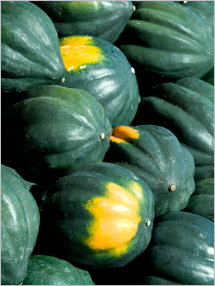 |
Acorn This acorn-shaped squash is one of the most widely available among the small winter squash. It measures about 6 inches around and weighs 1 to 2 pounds. Baking is an excellent way to bring out the sweet, nutty flavors of this tender fleshed squash. |
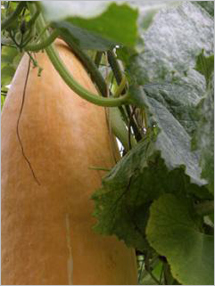 |
Banana This squash comes in three varieties: blue, orange, and pink. Among the three varieties, the pink banana is the most common in the United States. It is grown commercially in Florida. This large, thick-skinned cylindrical squash averages 20 inches long and weighs around 12 pounds. It is so large that it is usually sold in chunks instead of whole. Its creamy textured orange flesh offers a fruity and buttery delight to your palate. Although both baking and steaming are great ways to prepare this tasty squash, steaming produces a slightly sweeter, yet mild flavor. |
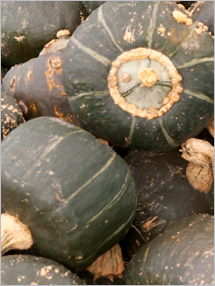 |
Buttercup This stocky squash is 6 to 8 inches in diameter, averaging 2 to 4 pounds. Its popularity stems from its sweet and creamy orange flesh. Its shortcoming is that it tends to be a bit dry. Baking or steaming can solve this problem; the dry flesh becomes smooth and tastes similar to a mixture of honey, roasted chestnuts, and sweet potato. Even more than baking, steaming softens the flesh and creates a thick puree (Great for pies) |
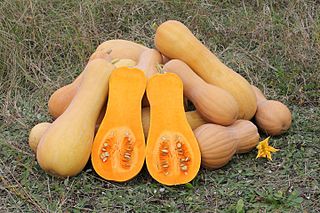 |
Butternut This elongated bell-shaped squash measures about a foot long and weighs an average of 2 to 4 pounds. Its popularity is due to its meaty, yet moderately sweet golden orange flesh. Because of its thin skin, this squash can easily be skinned with a vegetable peeler, which makes it easy to cut and prepare. Baking enhances its sweet, moist, and nutty flavors. Butternut squash is usually available from August through March. There are actually many variations of butternut. It can be used to make great "pumpkin" pies. |
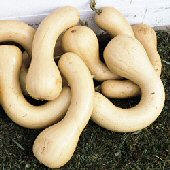 |
My favorite winter squash is one called
"Argos Gold", sometimes also simply called "Mexican Butternut" - it is
much longer than the usual "Waltham" butternut, often almost 2 feet long
and has a much sweeter taste and smoother texture. I've finally found
one supplier,
see this
page. I found another winter / butternut-type squash at Gurney's that looks promising . |
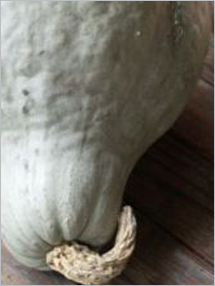 |
Hubbard This tear-shaped squash comes in several varieties: green (true), golden, blue, and baby blue. It ranges from dark green to orange and weighs from 5 to 50 pounds. Because of its size, Hubbard's popularity has decreased over the years. However, pre-cut portions of green and orange Hubbard can be found in markets. Green Hubbard's are thick, sweet, and dry. Golden Hubbard's; a smaller squash than the green or blue; are fairly sweet, but have a bitter aftertaste.The Blue or gray varietiey make wonder pumpkin pies! |
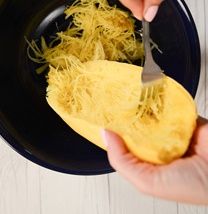 |
Spaghetti This oval-shaped yellow squash is also called the vegetable spaghetti. It averages 9 inches in length and may weigh 2 to 3 pounds. When cooked, the crisp, tender fhesh falls a apart into spaghetti-like strands that have a mild lightly sweet and fresh taste. Keep in mind that the larger the vegetable, the thicker the strands and the more flavorful the taste. It really is good with spaghetti sauce on the cooked squash "noodles" |
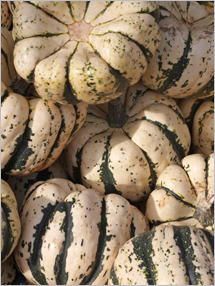 |
Sweet Dumpling This solid round squash, formerly known as the vegetable gourd, is a perfect serving for one person. It is about the size of an apple and weighs up to 1 pound. The skin is a warm cream color striped with ivy green, and it changes to butter color and orange during storage. The skin is relatively tender and can be eaten. The pale-yellow flesh is smooth, fine, and dry as a potato and produces a rich starchy, light to mild sweetness, with a slight corn flavor. |
Other Local Farm Products (Honey, Horses, Milk, Meat, Eggs, Etc.)
(NOT pick-your-own, unless they are also listed above)
- Farm markets and roadside stands
- Local Honey Finder
- Local Meat, Milk and Eggs
- Venues: Farms, Wineries, Orchards for your event, wedding or party
- Easter egg hunts
- Children"s consignment sales
- Fruit and vegetable festivals
- Winery tours and wine tastings
- Horse rides, stables, lessons, trails
- Maple Syrup farms and sugarworks
- Bed & Breakfasts on Farms, Wineries, Ranches and Orchards
- Pumpkin patches
- Corn mazes
- Zombie Paintball venues
- Christmas Tree Farms & lots
- Environmental resources
- Consumer fraud information
- Wholesale food sources
- Resources for Farmers
Looking for canning equipment and supplies?
Water bath canner with a jar rack
Pressure canners for gas, electric and induction stoves: Presto 23Qt or T-fal 22Qt
Canning scoop (this one is PERFECT)
Ball Blue book (most recent version)
Find Other types of farms:
- Easter egg hunts
- Children's consignment sales
- Farm markets and roadside stands
- Road trips and camping resources
- Local Honey, apiaries, beekeepers
- Local Meat, Milk and Eggs
- Consumer fraud and scams information
- Home canning supplies at the best prices on the internet!
- Maple Syrup Farms, sugarworks, maple syrup festivals
- Environmental information and resources
- Farms For Your Event for birthday parties, weddings, receptions, business meetings, retreats, etc.
- Festivals - local fruit and vegetable festivals
- Pumpkin patches and corn mazes
- Christmas Tree Farms and lots
Get the
most recent version of
the Ball Blue Book
Get the
most recent version of
the Ball Blue Book of Home Canning
Find other types of farms:
- Easter egg hunts
- Children's consignment sales
- Farm markets and roadside stands
- Local Honey
- Local Meat, Milk and Eggs
- Road trip and camping
- Pumpkin patches and corn mazes
- Christmas Tree Farms and lots
- Maple Syrup farms and sugarworks
Highly rated canning supplies:
- Regular Mouth Canning Lids with food-grade with BPA Free Silicone seals for Ball, Kerr Jars for Canning
- Canning accessories kit: funnel, jar tongs, lid lifter, etc
- Food Dehydrator, 400W Electric with 8 Trays, 48 hour Timer and Temperature Control 95-176℉, BPA-Free
- Water Bath Canner, 21 Qts with lid, Jar Rack, Speckled Black, cans 7 quart jars, 9 pint jars or 13 half-pint jars
- Air Fryer: Instant Pot Instant Vortex Plus XL 8QT Clear Windows, Custom Programming, 8-in-1
fruit dehydrator, Crisps, Broils, Roasts, Bakes, Reheats
- Pressure canner: All American 921, 21.5qt Pressure Cooker/Canner, never needs gaskets, Great for Gas, Electric or Flat Top Stoves - Made in the USA
- The Backyard Homestead: a guide to homesteading , on 1/4 acre, how to raise grains and vegetables; raise animals for meat, eggs, and dairy; and keep honey bees
- HEPA Air Purifiers for Home, Large Rooms for Allergies, Smoke, Pets. QUIET, Eliminates 99.97% of Dust, Pet Hair, Odors


